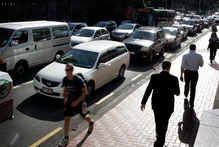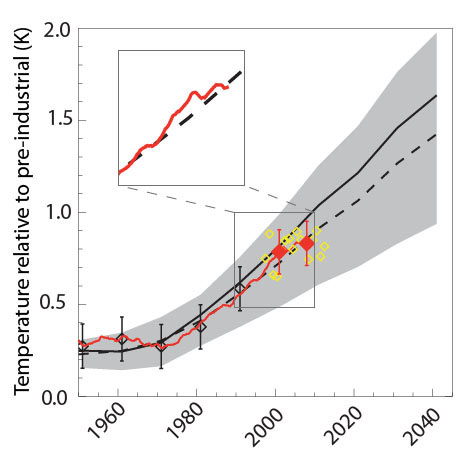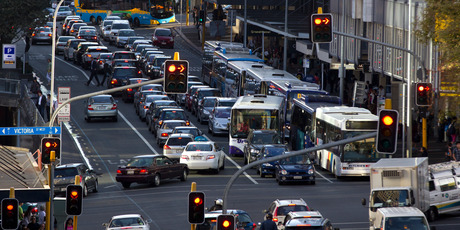Free public transport appears to
be something of a taboo subject both in society at large and in the
world of the social sciences. [
1]
And yet some 20 urban areas in France have bitten the bullet and gone
down this controversial path in recent years. The scintillating work
Voyageurs sans ticket. Liberté, égalité, gratuité : une expérience sociale à Aubagne
(“Passengers without tickets. Liberty, equality, charge-free: a social
experiment in Aubagne”) analyses one such experiment conducted in
Aubagne, a medium-sized town to the east of Marseille, and shows that
this apparent silence on the subject masks a certain timidity on the
part of decision-makers, researchers and citizens, to a large extent
linked to an inability to “think outside the box”. Its two authors –
Magali Giovannangeli, a communist local councillor in Aubagne, and
philosopher Jean‑Louis Sagot‑Duvauroux – offer a rigorous analysis of
free public transport that ultimately becomes a work of political
advocacy. In Aubagne, it would seem that free public transport has led
to a greater involvement of residents in local politics, as well as a
new sense of freedom, while at the same time offering a real alternative
to market forces. This work combines carefully argued analysis with a
clear stance on the public debate, and as such comes across as a
successful collaboration between a researcher and an elected
representative.
A social experiment in transforming “public space”
The analysis of the experiment is based first of all on figures, in
response to the economic arguments of the many “hostile opponents”
(p. 26) to such measures: the implementation of free public transport on
the 11 bus routes [
2]
that serve the 100,000 inhabitants of the Aubagne urban area has
resulted in a 142% increase in ridership across the network between 2009
and 2012, a 10% reduction in car journeys over the same period, a
service satisfaction rating of 99%, a drop in public expenditure per
journey from €3.93 in 2008 to €2.04 in 2011 – and all without any
increase in taxes for local residents. Presented like this, free public
transport appears to be an effective response to the problems of
passenger transport and pollution due to exhaust fumes.
But, above all, it is the analysis of the effects on the population
that should convince the reader of the merits of this measure. The
removal of social barriers, the soothing of tensions, greater
recognition for the work of bus drivers, and the end of ticket
inspections are all changes that have transformed users’ relationship
with transport. According to the authors, buses in Aubagne have – like
footpaths and other places where access is free of charge – now become
“public spaces” in the broadest sense of the term that have been
appropriated by “new citizens of public transport” (p. 120). The
hypothesis proposed, inspired by the thinking of philosopher Alexis de
Tocqueville (1981), is that the charge-free provision of a service is a
vector of freedom. In this regard, the second chapter of the book –
which places this hypothesis in a historical context – is particularly
enlightening: for example, schools, libraries and public spaces are all
free, and each of these places provides individuals with a form of
freedom.
Is social appropriation the key to the scheme’s success? This
hypothesis, put forward by the authors, can be discussed in the light of
recent studies concerning innovative mobility policies. For instance,
social appropriation was undoubtedly a factor in the success of France’s
first self-service bicycle-hire experiment, in La Rochelle in 1976 (
Huré 2012).
In Aubagne, think tanks were organised at the initiative of citizens or
set up by the Communauté d’Agglomération du Pays d’Aubagne et de
l’Étoile (the intermunicipal council covering the 12 towns and villages
in the Aubagne urban area) to promote and complement new practices among
users. In addition to reclaiming public space in this way, free public
transport is also seen as a means of involving citizens in the political
process, by helping them to “become aware” that transport policy is one
of the major political issues of the 21st century (pp. 124–126).
Finally, in the authors’ view, free public transport is something that
“goes against current trends and represents a clear alternative to the
market-based approach” (p. 35).
Free transport as a political alternative
The alternative to the market proposed by the authors is first and
foremost a political alternative. “Why does free public transport and,
more generally, alternative proposals to liberalism occupy such a small
space and have such poor visibility in left-wing manifestos?” (p. 208)
asks communist councillor Magali Giovannangeli, who, in the course of
this experiment, also begins to question her political identity. In
particular, she condemns the ideological inflexibility of the
traditional political parties, who prefer to regulate the price of
public transport using concessionary fares rather than promote free
public transport. In this introspective section of the book, both the
councillor and the philosopher – who handed in his Communist Party card
over 20 years ago – seem to effect an ideological shift and harness the
ideas of the degrowth movement (Mouvement de la Décroissance; p. 142).
Furthermore, the authors make no secret of the fact that the title of
their book is borrowed from
Liberté, égalité, gratuité by Paul Ariès (2011), a key intellectual figure in this movement.
These reflections allow us to question contemporary ideological
shifts, at a time when current debates all seem to converge on the word
“crisis”, particularly in the field of political thinking. Although not
cited, Ivan Illich’s theories on conviviality (Illich 1973a) and the
counterproductivity of industrialised transport systems (Illich 1973b) –
the very foundations of political ecology – are brought up to date
here: if one’s aim is to reduce the role of the car, it is necessary to
put in place tools that incentivise rather than restrict, and which
create spaces of freedom and conviviality (pp. 138–143). This book can
therefore also be read as a work that advocates a transformation of the
Left in France, and which promotes political alternatives rather than an
alternation of political parties. [
3]
However, it is also clearly a means of diffusing knowledge about this
experiment in France, as Aubagne wishes to play a leading role within
the network of towns that have implemented free public transport, while
awaiting the adoption of this measure by a European capital (Tallinn
in 2013).
A true fight against market forces?
Does making public transport free of charge really weaken the
influence of market forces? Although it attacks a fundamental value of
capitalism – commercial exchanges – the experiment is still organised
within the context of the market economy. As the authors concede, “a
company that has the necessary equipment and know-how, and which
provides an essential service to the population, cannot simply be
replaced” (p. 69); and, indeed, Veolia is still the transport operator
in Aubagne. Moreover, the public funding of free public transport is
provided by an increase in the
versement transport (transport contribution) [
4]
levied on businesses, a move which is not possible in all urban areas,
in particular those that have already reached their upper taxation
limits. Finally, although ticketing costs have been eliminated,
investments to improve clock-face scheduling have generated a 20%
increase in overall costs. During negotiations, Veolia also succeeded in
imposing a passenger-counting system, recovering €0.40 per passenger as
an incentive bonus.
Is it therefore possible that free public transport could, on the
contrary, reinforce the market by giving a new legitimacy and a positive
image to urban-services firms? This also raises serious questions about
the degree to which of public institutions can organise the market
(Hall and Soskice 2001), particularly in terms of the service offer
proposed. Accordingly, the authors believe that free public transport is
a means of opposing the integrated fare policies [
5] of large urban areas. Aubagne, for instance, forms part of the Marseille urban area geographically, [
6]
but has to date refused to join the city’s intermunicipal council, the
Marseille Provence Métropole (MPM) urban community, instead preferring
to create its own intermunicipal structure (the Communauté
d’Agglomération du Pays d’Aubagne et de l’Étoile, CAPAE). With this in
mind, the partnership with Veolia represents an additional,
non-negligible resource in Aubagne’s efforts to remain independent from
Marseille; indeed, MPM does not look upon Aubagne’s experiment kindly,
as it prevents fare harmonisation across the metropolitan area, unless
Marseille’s network were also to be made free of charge.
In addition, the agreement between the CAPAE and its public transport
providers was attacked by the prefect of the Bouches-du-Rhône
département
(in which Marseille and Aubagne are located) on technical grounds
relating to the compensation of transport companies in the context of a
public-service delegation. According to the authors, this procedure was
highly political in nature, representing the culmination of a clash
between the French state, represented at the time by Nicolas Sarkozy,
and a left-wing municipality (chapter 5: “Aubagne
vs Sarko”,
pp. 81–96). Nevertheless, this resistance to integrated fares may also
be seen as part of a fight to prevent the growth of private monopolies
across ever larger areas. In the Paris region, the implementation of a
flat-rate fare system, [
7]
managed by private operators, has preceded the creation of a Greater
Paris authority. As a result, certain authors have talked about
“back-to-front intermunicipality” (Baraud-Serfaty 2011), as the
construction of the market is taking place before the construction of
political institutions.
It is clear, therefore, that the choice between free public transport
and integrated fare systems has very real political implications. The
difference between these two competing measures concerns the way
local-government areas and powers are organised, in a context of ongoing
discussion and debate on the role of city regions in France. As we have
seen, this means that free public transport can become an instrument of
resistance wielded by medium-sized towns in the face of attempts at
political and territorial domination by larger urban areas. By
implementing an integrated fare system, these big cities use economic
stakeholders to organise their territories and political powers. Why
couldn’t Aubagne do the same with free public transport? In the field of
the social sciences, “thinking alternative” means opening up new
perspectives in order to understand the organisation of our contemporary
societies, [
8] a stimulating account of which is proffered here in
Voyageurs sans ticket.
Bibliographie
- Ariès, P. 2011. Liberté, égalité, gratuité : pour la gratuité des services publics !, Villeurbanne: Golias.
- Baraud-Serfaty, I. 2011. “La nouvelle privatisation des villes”, Esprit, nos. 3–4, pp. 149–167.
- CERTU. 2010. “Le débat : la gratuité des transports collectifs urbains ?”, Transflash, no. 352, April, pp. 1–3.
- GART. 2012. Une décennie de tarification dans les réseaux de transport urbain.
- Hall, P. and Soskice, D. (eds.). 2001. Varieties of Capitalism, Oxford: Oxford University Press.
- Huré, M. 2012. “De Vélib’ à Autolib’. Les grands groupes privés, nouveaux acteurs des politiques de mobilité urbaine”, Métropolitiques, 6 January (also available in English).
- Illich, I. 1973a. La Convivialité, Paris: Le Seuil.
- Illich, I. 1973b. Énergie et équité, Paris: Le Seuil.
- Tocqueville, A. de. 1981 (1st ed. 1835). De la démocratie en Amérique, vol. 1, Paris: Flammarion.





 Send
Send






